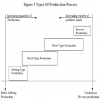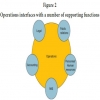Operations Management - Introduction to Operations Management
The boundary of the operations system
Posted On :
The simple transformation model given in the following diagram provides significant understanding and powerful tool for looking at operations in many different contexts.
The
boundary of the operations system
The simple transformation model given in the following diagram provides significant understanding and powerful tool for looking at operations in many different contexts.
It helps the decision maker to analyse and design operations in many types of organisation at many levels.
This model can be developed by identifying the boundaries of the operations system through which an organization’s goods or services are provided to its customers or clients. The diagram shows this boundary and added three components that are located outside it:
1. Suppliers
2. Customers
3. The environment

In any business, the set of suppliers provides inputs to the operations system. They may supply raw materials (for example sugarcane manufacturers provide sugarcane to Sugar Manufacturing units such as EID Parry / Sakthi Sugar etc; TVS is providing various nuts and bolts to automobile manufacturers / other equipment manufacturers), components (Prical provides speed measuring device to two wheeler manufacturers such as Hero Honda, Yamaha), finished products (for example a pharmaceutical company providing drugs to a hospital, or an office supplies company providing it with stationery) or services (as in the case of a law firm providing legal advice).
The customers (or clients) are the users of the outputs of the transformation process. The boundary drawn in the above diagram, represents the transforming process can be thought of as the boundary of the organisation, so that the whole organisation is viewed as an operations system, with its customers external to it. This may be an appropriate way of viewing a small organisation, whose outputs go directly to its external customers.
However, many macro operations are made up of a number of micro operations, or sub-systems. Only the outputs of the final micro operation go directly to a customer or client who is not part of the organisation that is carrying out the macro operation. The final user or client of the good or service is the organisation’s external customer, and the users or clients of the outputs of the other micro operations internal customers. Most of the operations in a large organisation serve internal, rather than external customers. For example, if you are the manager of a human resources department, a printing unit or a building maintenance section within a large organisation, your customers are internal: they are other sub-systems within the larger organisation that are external to your operations system but internal to the organisation as a whole.
All operating systems are influenced by the organization’s environment. This environment includes both other functional areas within the organisation, each with its own policies, resources, forecasts, goals, assumptions and constraints, and the wider world outside the organisation – the legal, political, social and economic conditions within which it is operating.
Changes in either the internal or the external environment may affect the operations function. Traditionally, organisations have kept the operations function separate from both its customers and its suppliers, in order to protect it from environmental disturbances (Thompson, 1967). This can lead to a ‘closed system’ mentality, in which the operations function loses contact with external customers and suppliers, and focuses only on the transformation process that it controls. A closed system tends to limit flexibility and result in a loss of competitiveness. An ‘open system’ mentality, in which communication with customers and suppliers is encouraged, seeks to reduce the barriers between the operations function and its environment, in order to enhance the organization’s competitiveness.
An added complication is that, as organisations become more complex, it becomes increasingly difficult to draw neat boundaries around the operations function. Operations management must therefore focus its attention on key interfaces within the organisation, as well as on interfaces between the organisation and its external customers and suppliers. Most operations systems are part of a supply chain that involves materials, information and customers, and the distribution of finished goods or services to customers or clients. It is therefore the responsibility of the operations function to co-ordinate the flow of information that links these activities through the supply chain. Thus, while some operations managers are concerned only with the transformation process within a single organisational unit, such as a factory or service outlet, many are involved in managing operations across several organisational units or even across separate organisations.
The simple transformation model given in the following diagram provides significant understanding and powerful tool for looking at operations in many different contexts.
It helps the decision maker to analyse and design operations in many types of organisation at many levels.
This model can be developed by identifying the boundaries of the operations system through which an organization’s goods or services are provided to its customers or clients. The diagram shows this boundary and added three components that are located outside it:
1. Suppliers
2. Customers
3. The environment

In any business, the set of suppliers provides inputs to the operations system. They may supply raw materials (for example sugarcane manufacturers provide sugarcane to Sugar Manufacturing units such as EID Parry / Sakthi Sugar etc; TVS is providing various nuts and bolts to automobile manufacturers / other equipment manufacturers), components (Prical provides speed measuring device to two wheeler manufacturers such as Hero Honda, Yamaha), finished products (for example a pharmaceutical company providing drugs to a hospital, or an office supplies company providing it with stationery) or services (as in the case of a law firm providing legal advice).
The customers (or clients) are the users of the outputs of the transformation process. The boundary drawn in the above diagram, represents the transforming process can be thought of as the boundary of the organisation, so that the whole organisation is viewed as an operations system, with its customers external to it. This may be an appropriate way of viewing a small organisation, whose outputs go directly to its external customers.
However, many macro operations are made up of a number of micro operations, or sub-systems. Only the outputs of the final micro operation go directly to a customer or client who is not part of the organisation that is carrying out the macro operation. The final user or client of the good or service is the organisation’s external customer, and the users or clients of the outputs of the other micro operations internal customers. Most of the operations in a large organisation serve internal, rather than external customers. For example, if you are the manager of a human resources department, a printing unit or a building maintenance section within a large organisation, your customers are internal: they are other sub-systems within the larger organisation that are external to your operations system but internal to the organisation as a whole.
All operating systems are influenced by the organization’s environment. This environment includes both other functional areas within the organisation, each with its own policies, resources, forecasts, goals, assumptions and constraints, and the wider world outside the organisation – the legal, political, social and economic conditions within which it is operating.
Changes in either the internal or the external environment may affect the operations function. Traditionally, organisations have kept the operations function separate from both its customers and its suppliers, in order to protect it from environmental disturbances (Thompson, 1967). This can lead to a ‘closed system’ mentality, in which the operations function loses contact with external customers and suppliers, and focuses only on the transformation process that it controls. A closed system tends to limit flexibility and result in a loss of competitiveness. An ‘open system’ mentality, in which communication with customers and suppliers is encouraged, seeks to reduce the barriers between the operations function and its environment, in order to enhance the organization’s competitiveness.
An added complication is that, as organisations become more complex, it becomes increasingly difficult to draw neat boundaries around the operations function. Operations management must therefore focus its attention on key interfaces within the organisation, as well as on interfaces between the organisation and its external customers and suppliers. Most operations systems are part of a supply chain that involves materials, information and customers, and the distribution of finished goods or services to customers or clients. It is therefore the responsibility of the operations function to co-ordinate the flow of information that links these activities through the supply chain. Thus, while some operations managers are concerned only with the transformation process within a single organisational unit, such as a factory or service outlet, many are involved in managing operations across several organisational units or even across separate organisations.
Tags : Operations Management - Introduction to Operations Management
Last 30 days 719 views














